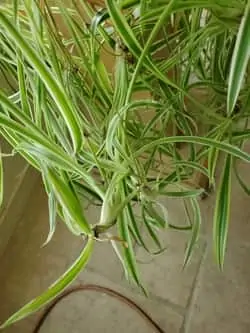The tropical beauty plant happens to be one of those house plants easy to care for and grow. This plant can grow under varied conditions and has fewer problems when caring for it. If you’re a newbie gardener, you could consider starting with the spider plant because of its ability to tolerate much abuse and survive under wild conditions.
You should use loamy, well-drained soil that has a ph balance of 6 to 6.5 and up to 7, put them in bright but indirect sunlight. Keep them moist but don’t overwater the plants because they can get root rot, let them dry out before you water them again.
When you are considering growing a spider plant, you should consider the type of soil, the amount of sunlight required to grow the plant, and other things, like the pot, fertilizer, and the appropriate location in your house to grow the plant. These are all required throughout the plant’s existence.
Table of Contents
What Soil Is Best for Growing Spider Plants?
Well-drained soils that are porous or closer to being sandy are most suitable for spider plants. This is because sandy or porous soils easily drain the water and keep the plant as hydrated as possible. This may avoid possible root rot and damage resulting from wet soil.
Since the plant is not placed directly in the sunshine where evaporation can easily occur, sandy loamy soils are preferred for growing spider plants. To keep the soil rich in nutrients, get a mixture of 30% and 70% of compost and soil.
There are several different types of potting soil that you can use for your spider plants. There is one called African Violet potting soil. African violet potting mixes have the perfect blend of nutrients, pH, and texture for your spider plant. there are also several others like Miracle-grow and others.

Caring for spider plants is a lot easier compared to other indoor plants. If your soil is well-drained and you get your lighting right, then you’re good to go as a grower of spider plants. You should also have in the back of your mind that this plant does well in cooler temperatures.
Pots for Spider Plants
When you are looking for a pot to grow your spider plant make sure that it has drainage holes in the bottom of it. There are all types of pots from plastic, ceramic, terracotta, wood, concrete, and fiberglass.
How Often Should I Repot a Spider Plant
A healthy, growing spider plant should be repotted every 1-2 years. They don’t mind being root-bound, but they have a tendency to grow fast and you end up, having to repot them quite often
Here are a few indications that might it right for a new planter or pot:
- If your plant’s roots are coming out of the pot’s drainage hole.
- Or if the roots are starting to show above the soil level in the pot.
- If the spider plant’s soil dries out quickly, which results in it having, some droopy leaves.
- If your pot has cracks or is broken.
If any of these apply to your spider plant, then it will probably appreciate some more space. But if it is fall or winter, you should wait until it is spring. If you are in the growing season, then you can repot it whenever it needs it.
A healthy, growing spider plant should be repotted every 1-2 years. They don’t mind being root-bound, but they have a tendency to grow fast and you end up, having to repot them quite often!
Here is a Tip for You: When you do repot your spider plant, you can put the plant into a bigger pot, or you can divide it into a couple of smaller pots.
How Often Should I Water a Spider Plant?
Spider plants should only be watered once a week. But before you water them, check the soil to see if it’s dry. Then if it is dry you can water it but If it’s still moist, you should wait another day and repeat this until the soil is dry
I know how anxious you could get to see your plant grow, especially newbie gardeners, but a spider plant does not require as much attention as you may think.
While spider plants are still growing, ensure you water them occasionally but not daily. Overwatering could leave its leaves brown or possibly die off. This has so far proven to be the main reason why spider plants die.
Watering the plant once or twice a week will suffice; the soil needs to get dry before you schedule another watering session. Be sure to keep track of the last time you watered it to avoid it from getting root rot seeing that this plant is susceptible to root rot if it is waterlogged.
You should be sure to dump the water that runs out from the bottom of the pot. If, during watering, you notice your plant has a lot of spots on the leaves, switch to using distilled water to eliminate some minerals, salt, and over-fertilizing the plants. Your spider plant is sure to thrive if you water it the right way.
Should I Fertilize a Spider Plant?
Yes, you should fertilize a spider plant. Use fertilizer mixed with water and fertilize the plant only when you see that growth is evident. The one shown below is great for spider plants. You can find it on Amazon.

The reason why you must allow it to grow actively is to ensure you’re not forcing its growth process with fertilizer. Also, keep in mind that over-fertilization is not healthy for any plant. Apply fertilizer twice a month to keep it healthy, and when the plant is mature, limit the fertilization to around 6 to 8 weeks or so.
Cleaning Spider Plant Leaves.
You can keep your spider plants clean by using a soft and clean cloth to dust or wipe the leaves or get the cloth lightly soaked with water to clean the leaves thoroughly. Make sure to clean the underside of the foliage and stems.
There are other quick methods you could use to keep the plant clean, like dusting with a feather duster, though this method is quicker when there is only a small layer of dust to be removed. It may be difficult to simply dust your spider plant because it has lots of leaves.
So you can get rid of the coated dust by rinsing its leaves in the sink or washbasin filled with water. Of course, you must handle the flower pot carefully to avoid any soil spillage.
You should invert the plant pot carefully, holding the soil and plant in the pot with one hand while you gently dunk the leaves in water. Allow the water to dry off before placing the pot where it is supposed to be.
If you’re skeptical your soil could spill off while washing the plant in the sink, make sure the soil is well watered or wrapped up in plastic to keep it bound before inverting the pot in the washbasin.
Can I Prune My Spider Plant?
Spider plants usually grow wild and can be up to 3 feet long. In that case, pruning its leaves in spring or summer keeps them healthy with a more desirable length and size. Be sure to prune the plant at the base using scissors or a small sharp pruner.

When pruning, always get rid of dead leaves or spots on the plant. On the mother plant, you may discover some mini spider plants or spider plant babies called spiderettes. These spiderettes can be pruned because they can easily grow into new plants. So here is what you need to do if you find baby plants on the mother plant;
If you want to grow another Spider Plant, remove one of the spider plant babies or as they are called spideretts. Then get a new or thoroughly cleaned small pot.
Then put in some loamy well-drained potting mix, then put the spiderette in the soil and water it. when it has rooted and grown then you can transfer it to a bigger pot. If you don’t want to have more plants then you don’t have to remove the babies, just remove the brown or dead leaves and stems.
Common Problems With Spider Plants
The most common issue related to spider plants is brown leaves that are caused mainly by overwatering or under-watering. As a result, always keep the soil moist, neither too dry nor wet.
They could also be infested by a colony of insects that infest house plants but can be easily removed with a cotton ball dipped in alcohol. These are some of the most common ones. Mealybugs · Aphids · Thrips · Spider mites · Whiteflies · Fungus gnats are the most known.
Recent Posts
Have you found yourself wondering, 'why is my bamboo growing so slow?' Despite the fact that bamboo plants are remarkably fast-growing, it can sometimes take months (or even years!) to see any signs...
Miracle-Gro is a huge help when you are trying to get decent yields out of your plants or if you want them to thrive. However, you may have noticed that a single dose of fertilizer does little to...
